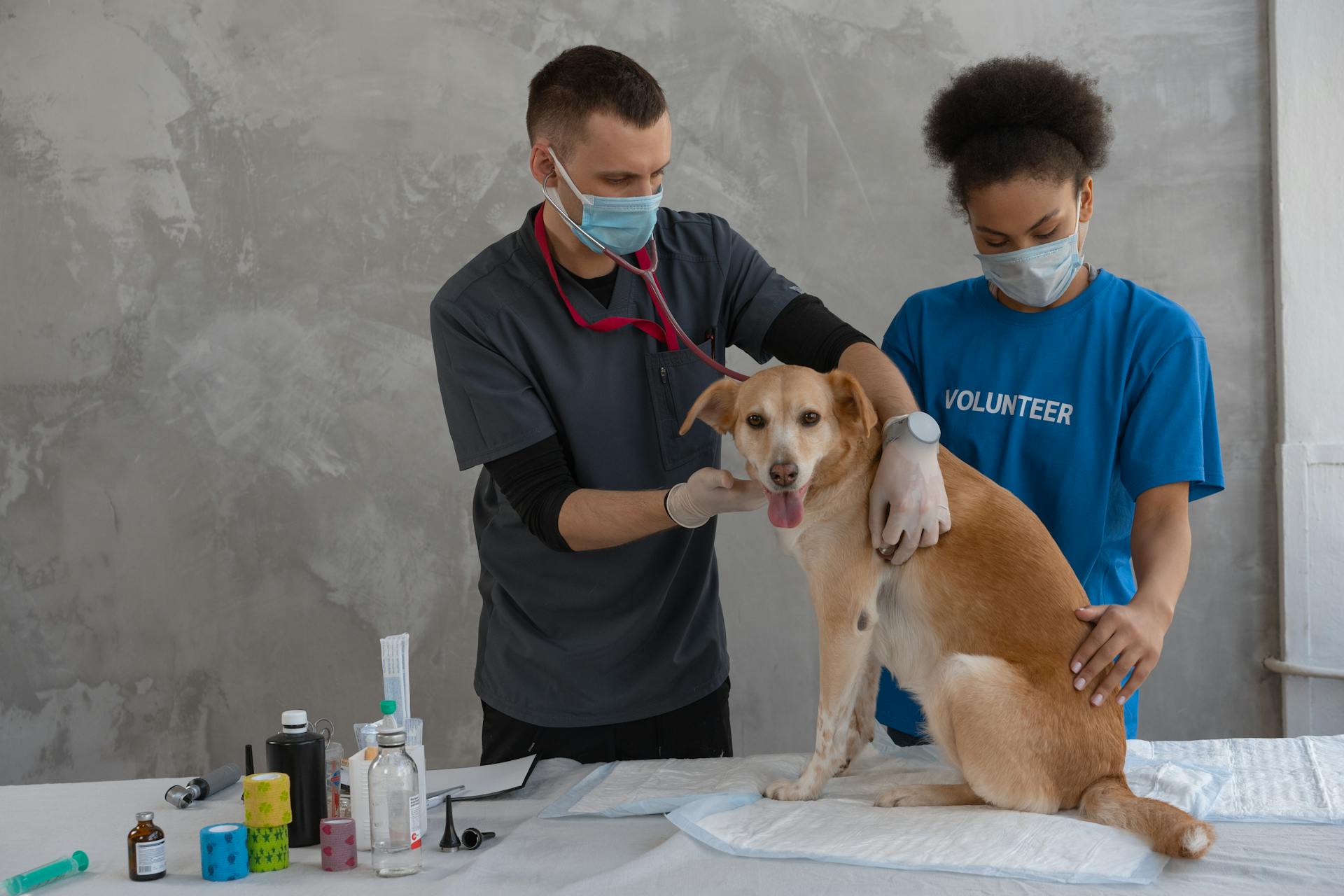
Multicentric lymphoma in dogs is a complex and multifaceted disease that affects many breeds, but it's most common in Golden Retrievers, Labrador Retrievers, and German Shepherds.
This type of lymphoma is characterized by the growth of cancerous cells in multiple lymph nodes throughout the dog's body.
The symptoms of multicentric lymphoma in dogs can vary, but they often include weight loss, lethargy, and swelling in the lymph nodes.
In most cases, the lymphoma is diagnosed through a combination of physical examination, complete blood count, and biopsy of the affected lymph nodes.
Diagnosis and Staging
Diagnosis typically starts with fine-needle aspiration (FNA) and cytologic evaluation of an affected lymph node or organ. Cytology is minimally invasive, less expensive than biopsy, and typically provides rapid results.
To confirm lymphoma, lymph node aspirates are usually examined immediately in-house and then sent to a laboratory for confirmation by a pathologist. In some cases, histopathology may be necessary to identify and classify indolent lymphoma.
The most important diagnostic test for lymphoma is lymph node biopsy, which is the gold standard for diagnosing lymphoma. High-grade lymphoma can often be diagnosed with simple FNA of the affected nodes.
Staging Tests
The following tests should be performed to stage lymphoma:
- Lymph node cytologic confirmation
- CBC
- Serum chemistry profile
- Urinalysis
- Phenotyping
- Abdominal ultrasonography
- Lymph node histology
- Thoracic radiography
- Bone marrow cytology
Diagnosis
Diagnosis is a crucial step in determining the type and severity of lymphoma. A thorough travel history should be obtained to rule out other possible causes of generalized lymphadenopathy.
Lymph node biopsy is the gold standard for diagnosing lymphoma. It involves removing a sample of tissue from an affected lymph node for examination.
Fine-needle aspiration (FNA) is a minimally invasive procedure that can be used to diagnose lymphoma. It involves inserting a thin needle into a lymph node to collect a sample of cells for examination.
FNA can often be used to diagnose high-grade lymphoma, but it's best to avoid aspirating the submandibular lymph nodes if another affected lymph node is available. This is because reactive lymph nodes have a more mixed population of lymphocytes.
Reactive lymph nodes have a more mixed population of lymphocytes, with lymphoblasts making up only approximately 50% of the population. Plasma cells are also common in reactive lymph nodes.
Cytology alone can be used to diagnose lymphoma in dogs, but it won't allow for classification. Immunophenotyping can be used to determine the cell line of origin and can be accomplished via flow cytometry or immunohistochemistry.
Immunophenotyping can be used to identify the proteins present on the surface or within the cytoplasm of a population of cells. These proteins are classified using the cluster of differentiation nomenclature (CD) and the expression of certain antigens can be specific to a particular lineage of cells.
Here's a list of some common antigens and the types of cells that express them:
Immunophenotyping can be used to differentiate clinically significant subtypes of lymphoma by objectively evaluating cell size, cell complexity and the expression of multiple leukocyte antigens.
You might like: T Cell Lymphoma in Dogs
Physical Examination Findings
Generalized peripheral lymphadenomegaly is the most common physical examination finding in lymphoma patients, seen in approximately 80% of cases.
Some dogs may only have internal involvement, such as hepatosplenic or gastrointestinal, which can make it difficult to diagnose through physical examination alone.
A lack of generalized lymphadenomegaly does not rule out lymphoma, as some cases may present with normal physical examination findings.
In some cases, physical examination findings may be normal, but suspicion for lymphoma is raised when hypercalcemia is identified during diagnostic evaluation.
Lymphoma in Dogs
Lymphoma is a common canine cancer that affects one of the white blood cells, and it requires chemotherapy in almost all cases.
The good news is that lymphoma is one of the most successfully treated cancers, with approximately 80% of dogs achieving a complete remission with chemotherapy.
Early detection and treatment are crucial for successful outcomes, and accurate diagnostics can help determine prognosis and assist in choosing treatment options.
A variety of protocol options are available, each with its own potential side effects and response rates. Consultation with a board-certified oncologist is recommended to navigate the testing and treatment options.
Dogs treated with chemotherapy live significantly longer than untreated dogs, and chemotherapy is well tolerated in most dogs, with only a minority developing significant toxicity.
The most common types of lymphoma in dogs are diffuse large B-cell lymphoma (DLBCL), peripheral T-cell lymphoma not otherwise specified (PTCL), T-zone lymphoma (TZL), T-cell lymphoblastic lymphoma (T-cell LBL), and marginal zone lymphoma (MZL).
Here's a breakdown of the common types of lymphoma:
Treatment and Goals
The goal of treating multicentric lymphoma in dogs is to induce clinical remission, which means getting rid of measurable disease, while maintaining a high quality of life. This is achieved through chemotherapy, which is the foundation of treatment.
Chemotherapy is not inhumane, and many clients are willing to administer daily medication or subcutaneous fluids to their pets. In fact, a weekly chemotherapy visit is often manageable when framed as treatment for a chronic condition, similar to renal or heart disease.
The median survival time for untreated high-grade lymphoma is 6 to 8 weeks, but treating with prednisone can improve quality of life and result in 2 to 3 months of survival time.
Most chemotherapy protocols have two phases: induction and consolidation. The induction phase is more dose-intensive and is designed to rapidly place the pet into remission, while the consolidation phase requires less frequent treatment and is designed to kill any remaining tumor cells.
The CHOP protocol is a common combination of drugs used to treat lymphoma in dogs. It consists of L-asparaginase, cyclophosphamide, doxorubicin, and vincristine, and is often used in combination with prednisone.
The University of Wisconsin-Madison protocol is often recommended for clients choosing a combination protocol because it has high complete remission rates and remission duration and is generally well tolerated.
Consider reading: Is High Protein Dog Food Good for Dogs
Prognosis and Considerations
The prognosis for dogs with multicentric lymphoma varies depending on several factors, including the type of lymphoma, age, and stage of the disease. Generally, dogs with T-cell lymphomas have shorter remission and survival times than those with B-cell lymphomas.
Broaden your view: Small Cell Lymphoma in Dogs
Dogs with T-zone lymphoma (TZL) tend to have a good prognosis, with a median survival time of 637 days. This type of lymphoma is typically diagnosed in older dogs with lymphadenopathy and peripheral lymphocytosis. In contrast, peripheral T-cell lymphomas (PTCL) have a more aggressive disease course and a median survival time of 159 days.
It's essential to note that the International Prognostic Index (IPI) used in human high-grade non-Hodgkin lymphoma has not been developed for canine lymphoma. However, studies have shown that dogs with DLBCL have a high rate of response to doxorubicin-based protocols and long survival, with a median survival time of 308 days.
A unique perspective: T Zone Lymphoma in Dogs
Prognosis
Dogs with T-zone lymphoma (TZL) typically have a good prognosis, with a median survival time of 637 days.
These dogs are usually older and have lymphadenopathy and peripheral lymphocytosis.
T-cell lymphomas, on the other hand, tend to have shorter remission and survival times compared to B-cell lymphomas.
Peripheral T-cell lymphomas (PTCL) have a particularly aggressive disease course, with a median survival of just 159 days.
DLBCL, the most common form of multicentric lymphoma, has a 90% response rate to doxorubicin-based protocols and a median survival time of 308 days.
In fact, DLBCL has one of the longest survival times among the various subtypes of lymphoma.
Dogs with LBL and PTCL, however, have the shortest survival times.
Expand your knowledge: Lymphoma in Dogs Survival Rate
Other Considerations
Obesity is a common issue in pets undergoing chemotherapy, especially with prednisone administration and overindulgent caregivers.
Significant weight gain can occur, leading to overdoses if chemotherapy doses aren't adjusted accordingly.
Having a little extra weight is not a bad idea, but too much can lead to orthopedic and other issues.
A word of caution on diet: many pet owners want to overhaul their pet's diet to support them through treatment, but this can be tricky.
Commonly, pet owners switch to "natural" or "cancer" diets, or even feed raw or home-formulated diets, which can be difficult to assess for GI toxicosis from chemotherapy.

Instruct clients to make a gradual change in their pet's diet, ideally after the induction phase of chemotherapy is over.
Encourage them to find a commercially available dog food, as many home-cooked diets are not nutritionally complete.
Feeding raw diets to cancer patients is not advised due to the risk of systemic infection from unprocessed meat.
Looking Ahead
New therapies are being developed to help canine lymphoma patients. Research is being done to create treatments tailored specifically to dogs.
Monoclonal antibody therapy and rabacfosadine (Tanovea CA-1) are two new therapies available to veterinary oncology teams. More research is needed to evaluate their effectiveness compared to current standards of care.
The goal of veterinary cancer therapy is to preserve quality of life and the human-animal bond. This remains the top priority in all cases.
Median survival is an important measure of a patient's prognosis, and it differs from mean survival in that it's not affected by extreme outcomes.
Additional reading: Are Therapy Dogs Service Animals
Staging & Prognosis
Staging is an essential process in determining the extent of multicentric lymphoma in dogs. A complete lymphoma staging should be performed, which includes tests such as lymph node cytologic confirmation, CBC, serum chemistry profile, urinalysis, phenotyping, abdominal ultrasonography, lymph node histology, thoracic radiography, and bone marrow cytology.
The World Health Organization (WHO) clinical stages of lymphoma are used to assign a stage based on the results of the staging tests. These stages range from I to V, with substage a indicating no clinical signs and substage b indicating clinical signs referable to lymphoma.
The WHO clinical stages of lymphoma are as follows:
Prognosis is an important factor in determining the outcome of lymphoma treatment. The International Prognostic Index (IPI) is used in human high-grade non-Hodgkin lymphoma, but a similar index has not been developed for canine lymphoma. However, studies have shown that T-cell lymphomas have shorter remission and survival times than B-cell lymphomas, with peripheral T-cell lymphomas having a median survival of 159 days.
In contrast, dogs with T-zone lymphoma (TZL) have a good prognosis, with a median survival of 637 days. DLBCL is a common form of multicentric lymphoma and has a high response rate to doxorubicin-based protocols, with a median survival of 308 days.
See what others are reading: Dog Food for High Energy Dogs
Lymphoma Key Points
Lymphoma is a common canine cancer that affects one of the white blood cells and requires chemotherapy in almost all cases.
Chemotherapy is a highly effective treatment for lymphoma, with a complete remission rate of approximately 80% for dogs treated with CHOP multiagent chemotherapy protocols.
Early detection and treatment are crucial for successful outcomes, as they can significantly improve the chances of a complete remission.
A board-certified oncologist can help determine the best treatment options for your dog, taking into account the potential side effects and response rates of various protocols.
Dogs treated with chemotherapy can live significantly longer than those who do not receive treatment, and most dogs tolerate chemotherapy well.
The minority of dogs that do experience significant toxicity from chemotherapy can still benefit from treatment, which is a testament to the effectiveness of this approach.
Here are some key statistics to keep in mind:
Most dogs treated with chemotherapy live a long and healthy life, making it a vital part of managing multicentric lymphoma in dogs.
Frequently Asked Questions
What is the life expectancy of a dog on the CHOP protocol?
Dogs on the CHOP protocol can live 10-14 months or more, depending on the stage and response to therapy
Sources
- https://todaysveterinarynurse.com/oncology/canine-multicentric-lymphoma/
- https://www.cliniciansbrief.com/article/canine-multicentric-lymphoma
- https://www.vetspecialists.co.uk/fact-sheets-post/lymphoma-in-dogs-fact-sheet/
- https://avim.us/canine-lymphoma/
- https://www.veterinary-practice.com/article/new-approaches-in-canine-multicentric-lymphoma
Featured Images: pexels.com


